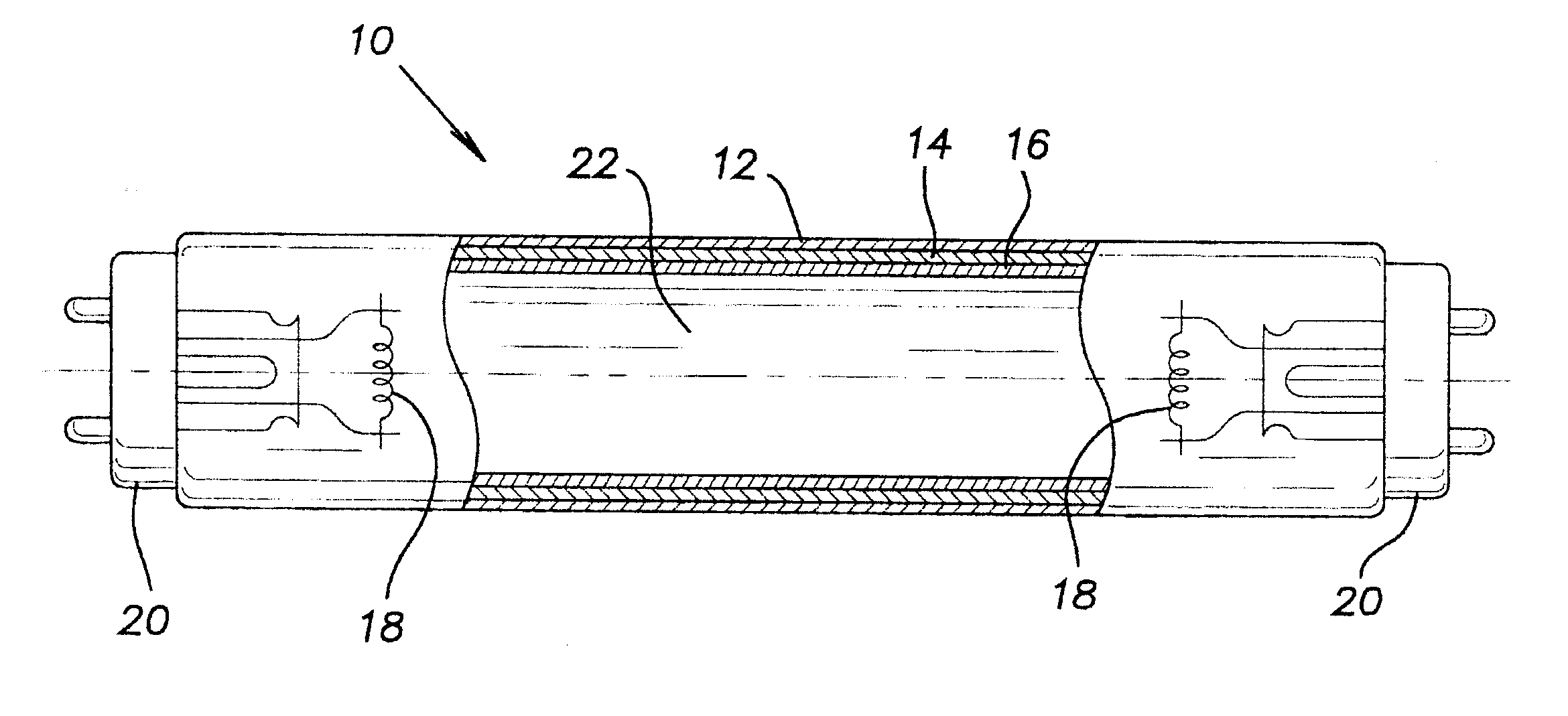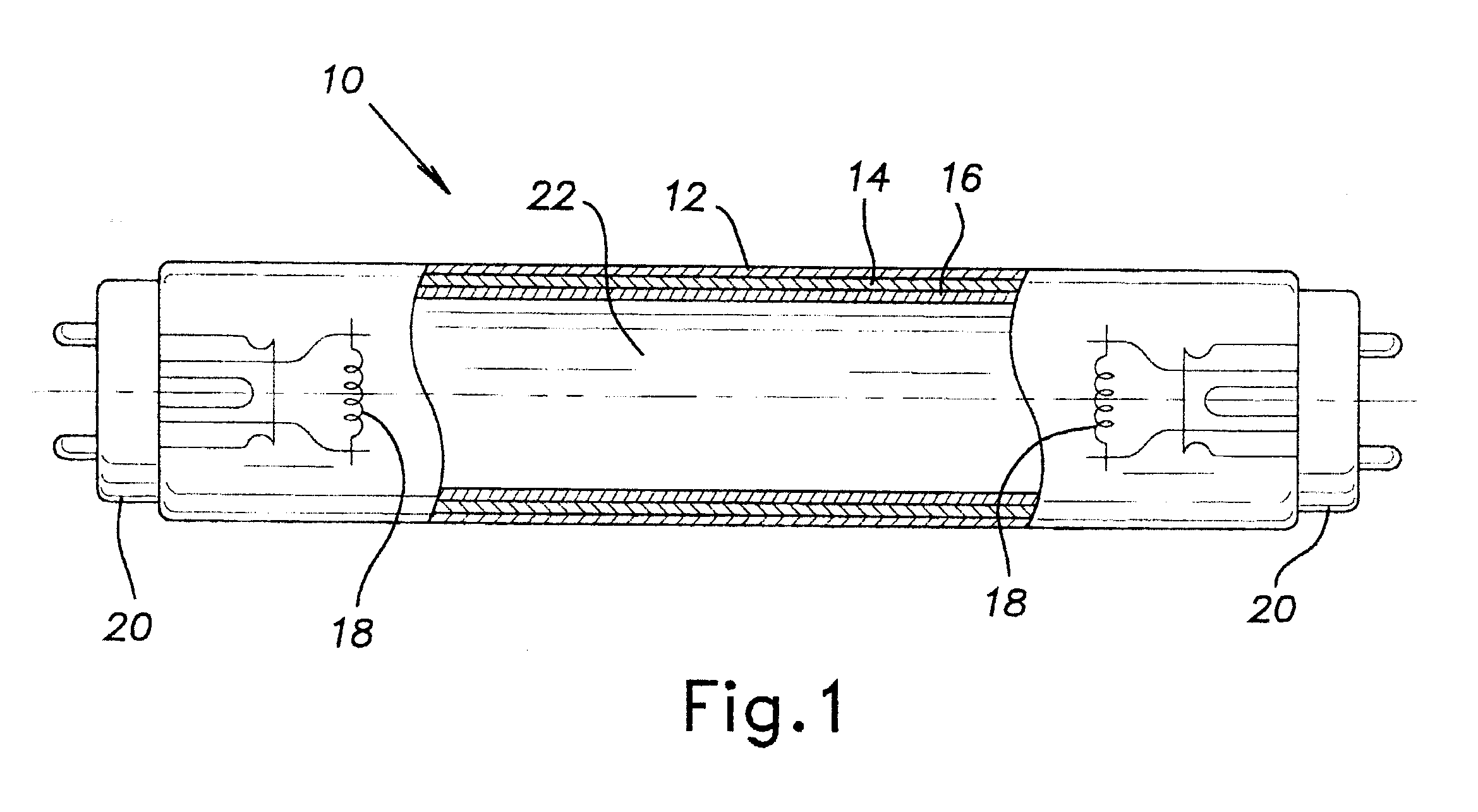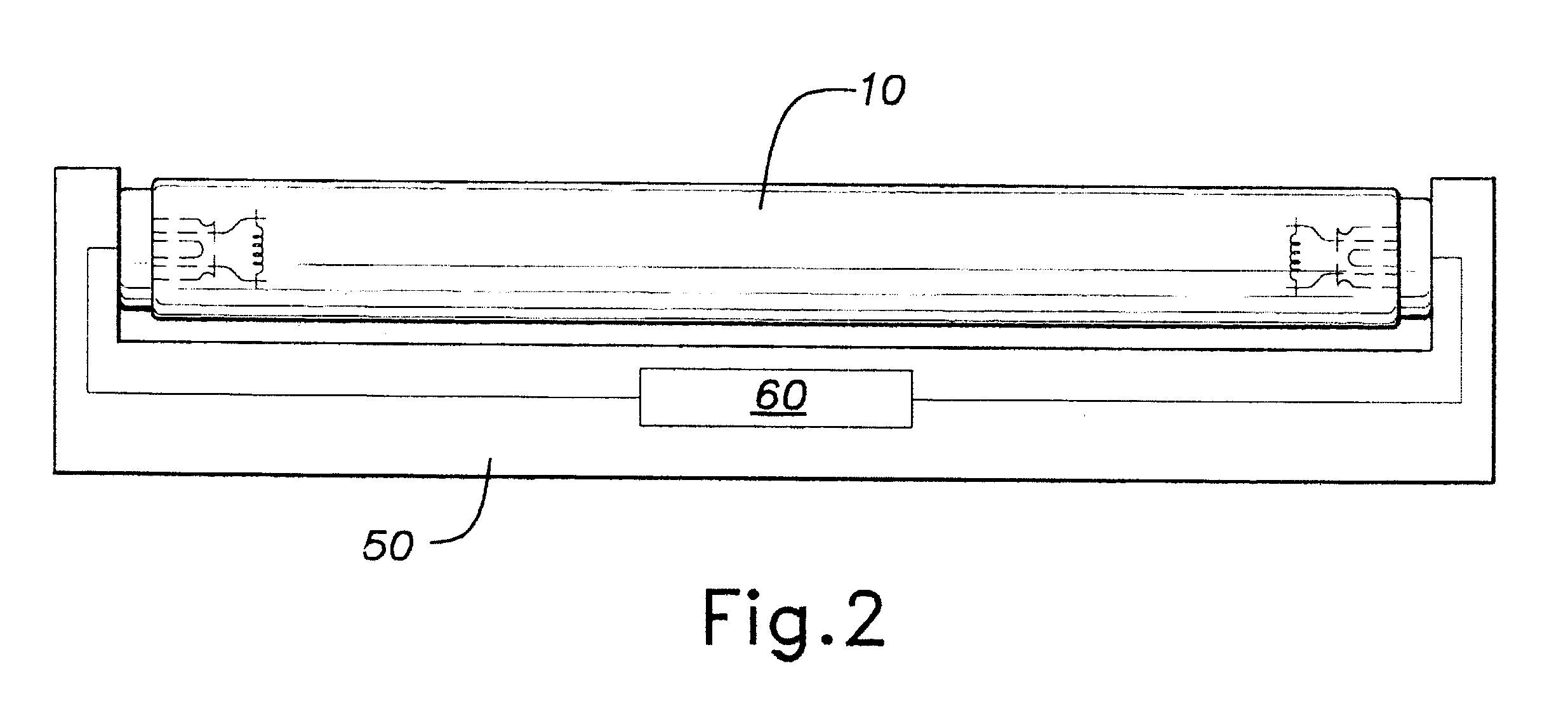The
phosphor layer 16 of the present invention is preferably disposed on the inner surface of the UV-reflective
barrier layer 14 and has a
coating weight of preferably 2.3-4.3, more preferably 2.5-3.9, more preferably 2.7-3.7, more preferably 2.8-3.4, more preferably 2.9-3.2, more preferably about 3.0, mg / cm.sup.2. This represents a significant increase in
coating weight over certain prior art, e.g. U.S. Pat. Nos. 5,008,789, 5,051,653, and 5,602,444, where typical coating weights of approximately 1.2 and 1.7 mg / cm.sup.2 have been employed, for example, in General Electric Company's well known STARCOAT.TM. SP and SPX type lamps respectively. A T8 fluorescent lamp according to the present invention, though nominally more costly due to material costs, consumes less energy to produce the same lumens when used in conjunction with existing electronic ballasts. Increased phosphor coating weight, in conjunction with the
alumina barrier layer 14 as described above, results in greater than 99% absorption of all the UV
radiation generated by the
discharge, and subsequent conversion into visible light. This results in about a 3% increase in efficiency over existing high performance General Electric SPX lamps which are generally known in the art. Hence, fluorescent lamps of the present invention consume less energy to produce the same lumens due to improved lamp efficiency.
The
inert gas of fill gas 22 preferably comprises a mixture of
argon and
krypton. Optionally, the
inert gas can be 100% substantially pure krypton. The
inert gas for standard T8 fluorescent lamps is
argon.
Inert gas mixtures of argon and krypton are generally known in the art for certain lamps. Such mixtures, for example, commonly have been used in low-wattage prior generation T12 lamps. The addition of krypton reduces
energy consumption in fluorescent lamps because krypton, having a higher atomic weight than argon, results in lower
electron scattering and heat conduction losses per unit length of the discharge. However, a major
disadvantage of krypton is that it suppresses Penning effect
ionization, thereby making the lamp difficult to start on a standard 110V
ballast without a starting aid. Up till now, this has kept
inert gas compositions in fluorescent lamps below 40 vol. % krypton absent a starting aid.
A common starting aid is a film of semi-conducting
tin oxide doped with
fluorine or
antimony applied to the inner surface of the glass envelope 12 via
spray pyrolysis. During starting, the discharge capacitively couples to the coating and current passes along the wall until the discharge itself becomes conducting. However, such a film requires an additional coating step and is difficult to apply correctly, thus contributing to increased manufacturing time and cost. Additionally, the starting aid film reduces lumen output by 1-2.5 percent. Hence, in lamps requiring a starting aid to counter the effect of krypton,
energy cost savings is at least partially offset by reduced lumen output and the added cost of the starting aid.
Previous generation low-wattage T12 lamps employing starting aids typically contain 75-90 percent krypton in the inert gas, balance argon. Such a
high ratio of krypton contributes significantly to the difficulty in starting fluorescent lamps.
Surprisingly and unexpectedly, it has been found that by reducing the total fill
gas pressure to 0.5-3
torr at 25.degree. C., improved lumen efficiency and easier lamp starting are achieved while striations are reduced or substantially eliminated in lamps having krypton levels up to 55 vol. % when used with conventional ballasts. Easy starting and substantial
elimination of striations are also achieved in lamps having krypton levels up to 100 vol. % when used in conjunction with an invented
ballast as described below. It has been observed that when striations do occur in an invented lamp, they exist only temporarily, e.g. for about or less than one minute after the lamp is started. For example, a 10% increase in lumen efficiency has been observed in invented lamps containing 40 vol. % krypton in the inert gas at a total fill gas 22 pressure of 1.5-1.9
torr compared to a typical 4" T8 lamp operated on a standard 60 Hz
reference circuit. These invented lamps required no starting aid. Further, a 15% increase in lumen efficiency has been observed for an invented lamp having 95 vol. % krypton in the inert gas. Even higher lumen efficiencies, e.g. up to 20% increase over standard T8 lamps, have been achieved with commercial high frequency ballasts. A lamp having an inert
gas composition and total fill
gas pressure as described above reduces
power consumption, yet requires no starting aid.
The invented lamp having high krypton content (e.g. 40-100 vol. %), and particularly those having 56-100, 60-100, 70-100, or 80-100, vol. % krypton in the inert gas, may experience difficult starting with certain existing ballasts present in the marketplace. When used with these certain ballasts, the invented lamp may also exhibit some striations. However, both of these effects are overcome by
coupling the lamp with an invented
ballast 50 to provide a low-wattage
lighting system according to the invention.
 Login to View More
Login to View More  Login to View More
Login to View More 


